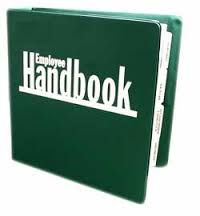Employee handbook will eliminate confusion as to what you expect from your employees. As the owner of small company, you may wish to set policies yourself and take full responsibility for drafting enforcing, reviewing and updating all information in the employee handbook. If, however, you run or manage a large business, this duty usually falls upon the shoulders of the human resources department/employee relations manager.
Either way, make sure that all policies, procedures, practices, rules and regulations are decided upon in advance, and present ideas in a simple and direct manner by choosing short words that define the company’s position.
During the orientation process, each employee should receive a copy of the handbook, and any updated versions should be presented to existing employees to keep a constant flow of communication going. Sufficient feedback from employees will also help management understand exactly what kind of information would be useful to include to help an employee be effective on the job.
Items usually included in a handbook are:
- Absences
- Accidents
- Benefits
- Cleanliness
- Coffee breaks
- Complaints
- Confidentiality of work
- Decorum
- Discrimination
- Dismissals
- Emergencies
- Fire
- Intoxication
- Military service
- Misconduct
- Office supplies usage
- Ordering of supplies
- Organizational chart
- Orientation
- Overtime
- Parking for employees
- Paydays
- Pay periods
- Pension plans
- Personal mail
- Personal phone calls
- Personal visitors
- Probationary periods
- Professional ethics
- Promotions
- Re-employment rights
- Resignations
- Retirement
- Salary calculations
- Salary deductions
- Schedule of work
- Sick leave
- Smoking policies
- Tardiness
- Temporary employment
- Time cards
- Work evaluation
- Work habits
- Work periods
- Working hours
- Worker’s compensation
Make sure when the handbook is being drafted that all practices are consistent with the company’s growth plans reflect current company philosophies and objectives. Also, two disclaimers should be included in the introduction to the handbook:
1. The handbook is not an employment contract between the employee and the organization.
2. Employees may be dismissed at the discretion of the company.
Including these disclaimers in your handbook will help you to avoid future litigation from terminated employees. When the handbook is finished, it should be reviewed by legal counsel to make sure that it’s consistent with current federal, state and local employment regulations.
The employee handbook is important to your organization’s growth and structure because it communicates to the employees just what the employer expects and what the company will provide in terms of a productive working environment. More importantly, it forces the employer to be consistent in the enforcement of company policy instead of allowing it to shift from person to person or situation to situation. Employees like to feel that they will receive equal treatment, regardless of the situation or position. This feeling of equality promotes a team atmosphere that’s important to productivity.
Perhaps the greatest benefit of an employee handbook is its ability to focus the attention of employees on the performance of their jobs. It relieves the worries that accompany an employees’s lack of understanding concerning policies and benefits.
Employee Handbook: Advantages and Disadvantages
There are many advantages to creating employee handbooks. Employers generally benefit from increased communication with employees regarding company policies, benefits, and work rules. However, employers must be willing and able to honor commitments made in the handbook. Additionally, poorly drafted, maintained or enforced handbook policies can be the source of many problems for employers.
One advantage of an employee handbook is the improved communication between employers and employees. An employee handbook is an opportunity for the employer to communicate with its employees about work place practices and procedures. This is particularly helpful to new employees who can become better acquainted with work place practices at the outset of their employment.
An employee handbook is also a good location to communicate guidelines and policies under which a company operates. It is a source both for the employer to announce, clarify or change policies and also for the employee to look to for a common understanding of the company’s standards of conduct. In addition, the handbook can express the company’s mission and can contribute to the furtherance of the company’s corporate culture.
By understanding what the company expects of the employee and what the employee can expect of the company, an employee handbook helps to minimize anxiety of employees by decreasing fear of the unknown. The manual can clearly and specifically define everything from the nature and status of the employment relationship, to the ramifications and process which will be followed in the event of employee misconduct or poor performance.
Today, many employers use an employee handbook in order for everyone to know the different policies that are being implemented in the company. This tool covers all the issues that may be involved in the relationship of both employers and employees.
However, it can also cause misunderstandings and disputes if it was not carefully made or drafted. In order to avoid problems which can arise from an employee handbook, it is advisable that you acquire legal assistance and guidance from a Los Angeles labor attorney before you make it.
Advantage
Your attorney will make sure that these following issues will be covered by the employee handbook:
- Attendance- Inform your employees that you expect them to show up for work, unless they have a valid reason for being absent. The handbook should state that an employee who is always absent will be subjected to different disciplinary actions.
- Salary- Since salary is a primary concern of your employees; you should make sure that it will be included in the handbook. The handbook should state the way on how their salary is computed.
- Dispute resolution- The workplace is occupied by people who have different personalities and beliefs so there may be instances when disputes are unavoidable. You should think of ways on how the problem can be resolved outside of the court. Employees who are involved in a dispute may be required to undergo an Alternative Dispute Resolution (ADR) process like mediation or arbitration.
An employee handbook will enable you to control the performance of your employees. Through this manual, employees will know their duties as well as the different things that you expect from them.
Having an employee handbook can be an advantage because it:
- Enables your employees to know what kind of working relationship should exist between you and them
- Allows you to implement rules which can create a productive and harmonious working environment
- Provides different rules which cover all employees, not just selected ones
- Provides an effective way to communicate with your employees
Although an employee handbook can be help you in many ways, it can also become the cause of different misunderstandings in the workplace
Disadvantages
Here are the different disadvantages of having one:
- You may need to update it regularly so that it can cover new company polices
- You may be exposed to different liabilities if the handbook was not carefully made
- You may not be able to fulfill promises that you have included in it, especially ones that cover salary raises and other benefits
Finally, the employee handbook offers an opportunity to state affirmatively and confirm that employment is at will, thereby possible insulating the company from many claims. This helps to put all parties on notice as to the nature, scope and rules of the working relationship from the outset.
















